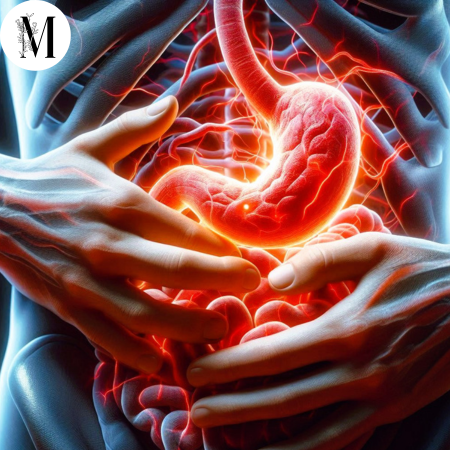Introduction:
A big belly is often associated with being overweight or obese. However, there are instances where individuals may have a protruding abdomen without being significantly overweight. In this article, we will explore four types of big bellies that aren’t caused by excessive body weight. These conditions can vary from harmless anatomical features to underlying health issues. Understanding these different types can help individuals recognize the cause of their big belly and seek appropriate medical attention if needed.
1-Visceral Fat:
Visceral fat, also known as intra-abdominal fat, is found deep within the abdominal cavity and surrounds vital organs such as the liver, intestines, and pancreas. This type of fat is different from subcutaneous fat, which lies just beneath the skin. Even individuals with a normal body weight can have excess visceral fat, leading to a protruding belly. Visceral fat accumulation is often associated with sedentary lifestyles, poor diet, and genetic factors. It poses significant health risks, including increased risk of heart disease, diabetes, and metabolic disorders. Regular exercise, a healthy diet, and lifestyle modifications are essential for managing and reducing visceral fat.
2-Posture and Weak Abdominal Muscles:
Poor posture and weak abdominal muscles can contribute to the appearance of a big belly. When the muscles in the abdomen are weak, they are unable to provide adequate support to the organs and abdominal wall, causing the abdomen to protrude forward. This condition is commonly referred to as anterior pelvic tilt. Prolonged sitting, lack of exercise, and certain occupations that involve constant sitting or standing can weaken the abdominal muscles. Physical therapy, specific exercises targeting the core muscles, and maintaining good posture can help alleviate this issue.
3-Bloating and Digestive Issues
Bloating refers to the uncomfortable sensation of a distended abdomen caused by excess gas or fluid in the digestive system. Certain foods, such as beans, lentils, cruciferous vegetables, and carbonated drinks, can produce excessive gas and contribute to bloating. Digestive disorders like irritable bowel syndrome (IBS), celiac disease, and lactose intolerance can also cause bloating. These conditions affect the normal functioning of the gastrointestinal tract and can result in a visibly distended belly. Managing bloating involves identifying trigger foods, maintaining a balanced diet, and seeking medical advice if symptoms persist.
4-Hormonal Imbalances
Hormonal imbalances, particularly in women, can lead to a big belly. Polycystic ovary syndrome (PCOS), a common hormonal disorder, can cause weight gain and increased fat accumulation in the abdominal area. Insulin resistance, elevated levels of androgens (male hormones), and irregular menstrual cycles are characteristic features of PCOS. Hormonal changes during menopause can also contribute to abdominal weight gain. It’s important for individuals experiencing unexplained weight gain or changes in body shape to consult a healthcare professional who can evaluate hormone levels and recommend appropriate treatment options.
5-Abdominal Hernia
An abdominal hernia is another possible cause of a big belly that is unrelated to overweight. It occurs when an organ or tissue pushes through a weakened area of the abdominal wall, creating a bulge. The most common types of abdominal hernias include inguinal hernias (groin area), umbilical hernias (around the belly button), and incisional hernias (at the site of a previous surgery). Factors such as obesity, pregnancy, heavy lifting, chronic coughing, and a family history of hernias can increase the risk of developing an abdominal hernia. Treatment typically involves surgical repair to reinforce the weakened area and prevent further complications.
6-Ascites
Ascites is the accumulation of fluid within the abdominal cavity. It can cause the abdomen to appear distended and enlarged. Ascites is commonly associated with liver disease, particularly cirrhosis, where liver function is compromised, leading to fluid retention. Other causes of ascites include heart failure, kidney disease, certain cancers, and infections. Treatment involves addressing the underlying condition, restricting salt intake, and in some cases, draining the accumulated fluid through a procedure called paracentesis.
7-Cushing’s Syndrome
Cushing’s syndrome is a hormonal disorder caused by prolonged exposure to high levels of the hormone cortisol. This can occur due to the use of corticosteroid medications or excessive production of cortisol by the adrenal glands. One of the visible signs of Cushing’s syndrome is weight gain, particularly in the abdomen, face, and upper back. The accumulation of fat in these areas can give the appearance of a big belly. Treatment involves addressing the underlying cause, reducing or discontinuing corticosteroid use, and sometimes surgical intervention.
Conclusion:
While excess body weight is often associated with a big belly, there are various other factors that can contribute to this condition. Visceral fat, weak abdominal muscles, bloating, and hormonal imbalances can all result in a protruding abdomen. Understanding these different types of big bellies is crucial for individuals seeking to address their concerns and adopt appropriate measures to improve their overall health and well-being. If you have concerns about your abdominal size or are experiencing any related symptoms, it is always recommended to consult a healthcare professional for an accurate diagnosis and personalized treatment plan.


